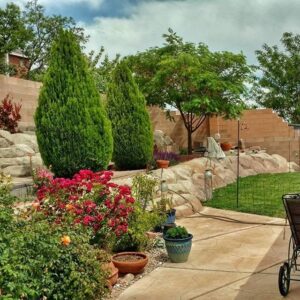10 Tips for Sustainable Landscaping Design
As our planet faces environmental challenges, sustainability has become critical in every aspect of our lives. This includes designing and maintaining our outdoor spaces, such as gardens and lawns. In this blog article, we’ll discuss ten tips for creating a sustainable landscaping design that benefits the environment and adds beauty and functionality to your outdoor area.
Start with a Plan
When starting to plan your sustainable landscaping design, it’s important to consider the layout and purpose of your outdoor space. Think about how you want to use the area – do you want a space for relaxing and entertaining, or maybe a garden for growing fruits and vegetables? This will help determine how much space you have available for different elements in your design.
Another key factor to consider is the natural elements in your area, such as sunlight exposure and soil type. These factors will play a role in what types of plants will thrive in your landscape and where they should be placed. You’ll also want to take into account any existing structures, trees, or other features that you may want to incorporate into your design.
Having a clear plan in place before starting your sustainable landscaping project will save you time, money, and potential headaches in the long run. It’s always better to have a solid foundation to work from rather than making decisions on the fly. So take the time to create a well-thought-out plan and watch your sustainable landscape come to life!
Choose Native Plants
One of the best ways to create a sustainable landscaping design is by choosing plants that are native to your region. These plants are already well-adapted to the local climate and require less maintenance, making them an eco-friendly choice for your outdoor space.
Not only do native plants benefit the environment, but they also add beauty and diversity to your landscape. They attract pollinators and wildlife, creating a balanced ecosystem in your backyard.
When selecting native plants for your design, make sure to research which ones are best suited for the specific conditions of your area. This will ensure that they thrive and require minimal care from you. So instead of planting exotic species, opt for native plants in your sustainable landscaping design. Your local environment will thank you!
Use Drought-Tolerant Plants
Another way to create a sustainable landscaping design is by using drought-tolerant plants. These types of plants require less water and can thrive in dry conditions, making them perfect for areas with limited access to water. Some examples of drought-tolerant plants include lavender, agave, and yucca.
Moreover, incorporating these types of plants into your design can also save you money on your water bill and reduce the need for irrigation systems. Additionally, they can add unique textures and colors to your landscape, making it visually appealing.
By using drought-tolerant plants in your landscaping design, you can create a beautiful and eco-friendly outdoor space while also promoting water conservation. So don’t be afraid to get creative with these types of plants in your design!
Consider Permaculture Principles
Another important aspect of permaculture principles to consider in your sustainable landscaping design is the concept of zoning. This involves dividing your outdoor space into different zones based on their functions and needs.
For example, a vegetable garden would be placed in a zone that receives ample sunlight and water, while a composting area would be located closer to your house for easy access.
Additionally, polyculture planting is another permaculture technique that can be beneficial in your landscaping design. This involves planting a variety of plants together, which can help increase biodiversity and create a more resilient ecosystem.
By incorporating these principles into your sustainable landscaping design, you are not only creating a beautiful outdoor space but also working towards building a self-sufficient and environmentally friendly environment. Just remember to regularly assess and adjust your design as needed to maintain a sustainable balance.
Use Recycled or Reclaimed Materials
Instead of buying new materials for your landscaping design, consider using recycled or reclaimed materials. Not only is this a more sustainable option, but it can also add unique and interesting elements to your outdoor space. For example, you can use old tires as planters or repurpose wood pallets for raised garden beds.
Incorporate Rainwater Harvesting
Collecting rainwater is not only beneficial for your plants and soil, but it also helps reduce your water bill. By incorporating a rainwater harvesting system into your landscaping design, you can collect and store rainwater to use for watering your plants or even for household chores. This reduces the strain on local water resources and promotes sustainability in your community.
When implementing a rainwater harvesting system, make sure to place your rain barrels or other collection methods in areas that receive a lot of rainfall. You can also use the collected water to irrigate your garden through drip irrigation systems, which minimize water waste and promote healthier plant growth.
Make sure to regularly clean and maintain your rainwater harvesting system to prevent any potential health hazards. With the increasing concern for water scarcity, incorporating rainwater harvesting into your sustainable landscaping design is a small but impactful step towards conserving this precious resource. Plus, it’s a great way to reduce your carbon footprint and help combat climate change.
Choose Sustainable Hardscaping
Hardscaping is an important aspect of any landscaping design, as it adds structure and functionality to your outdoor space. However, it’s important to choose sustainable options when it comes to hardscaping materials. Here are a few tips to keep in mind:
- Opt for permeable hardscaping materials such as gravel or permeable pavers that allow water to infiltrate into the ground, reducing runoff and erosion.
- Use locally sourced materials to reduce transportation emissions and support your local economy.
- Consider repurposing existing materials on your property, such as old bricks or stones, for your hardscaping needs.
By choosing sustainable hardscaping options, you can minimize your environmental impact while still creating a beautiful and functional outdoor space. Keep these tips in mind when planning and designing your landscaping project.
Use Organic Soil Amendments and Fertilizers
Another important aspect of sustainable landscaping design is the use of organic soil amendments and fertilizers. These products not only benefit the environment by avoiding harmful chemicals but also promote healthier soil for your plants to thrive in.
Organic soil amendments, such as compost or manure, provide essential nutrients to the soil and improve its overall health. This leads to stronger and more resilient plants that are better equipped to resist pests and diseases.
Similarly, organic fertilizers made from natural sources like bone meal or seaweed can provide the necessary nutrients for your plants without causing harm to the environment. These products also promote long-term soil health by increasing microbial activity and improving soil structure.
Implement Integrated Pest Management
Pesticides can be harmful to both the environment and human health. Instead of relying on these chemicals, consider using integrated pest management techniques to control pests in your landscaping design. This includes natural methods such as companion planting and introducing beneficial insects.
Practice Sustainable Maintenance
Finally, maintaining a sustainable landscape also involves ongoing practices. This includes properly watering and mulching your plants, pruning them when needed, and regularly removing weeds without the use of harmful chemicals.
By following these 10 tips, you can create a beautiful and sustainable landscaping design that benefits both your outdoor space and the environment. Remember to always prioritize sustainability in your decision-making process and continue to educate yourself on ways to minimize your environmental impact.
Together, we can all contribute to a more sustainable future for our planet. So let’s get out there and start designing our eco-friendly outdoor spaces! Happy gardening!



